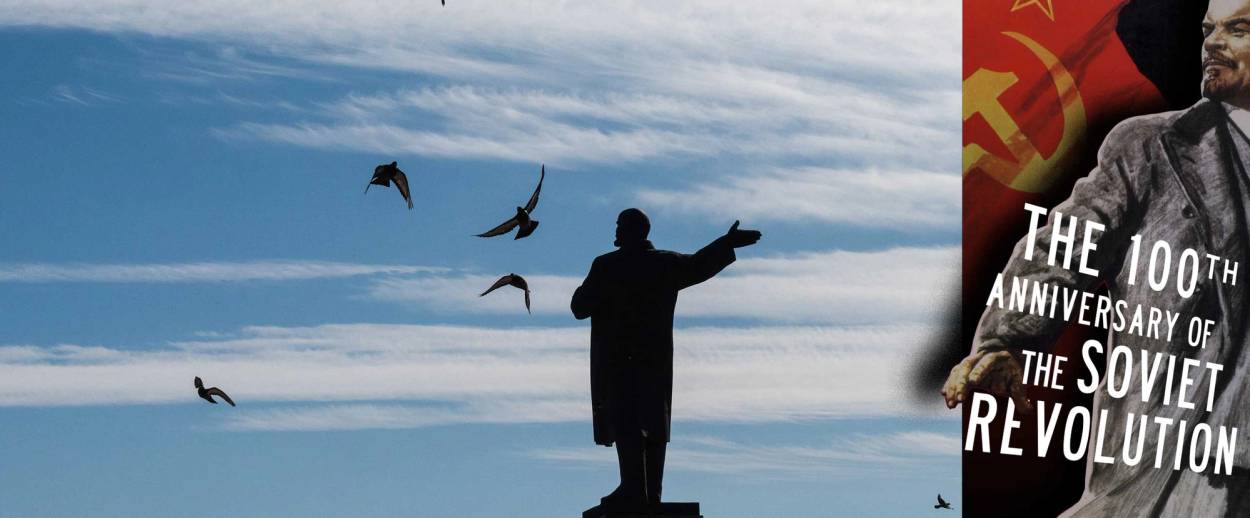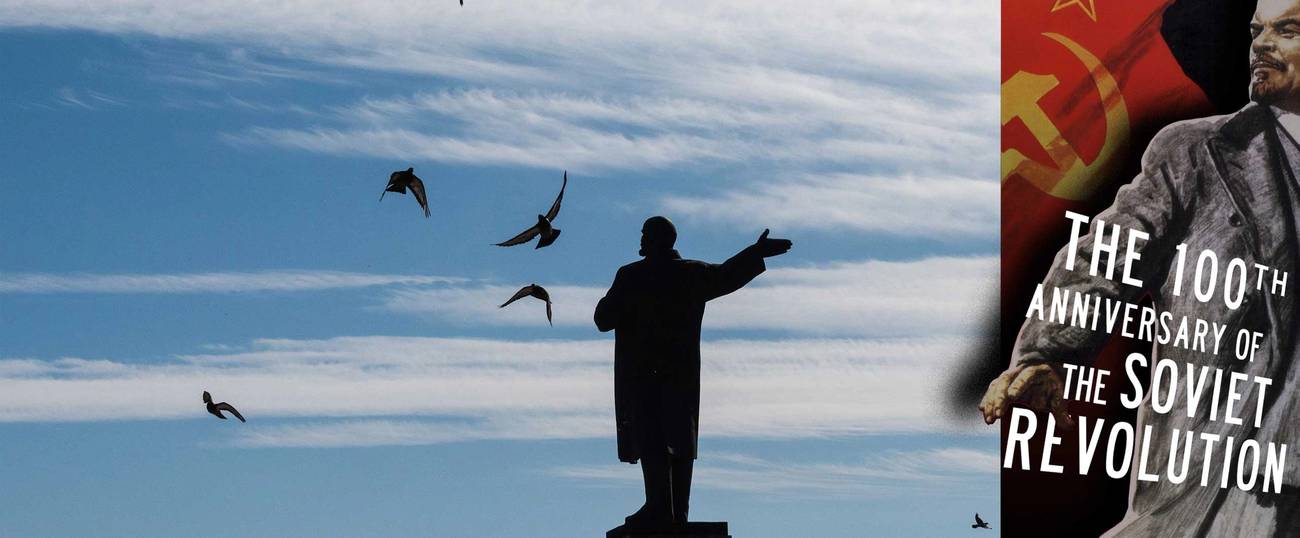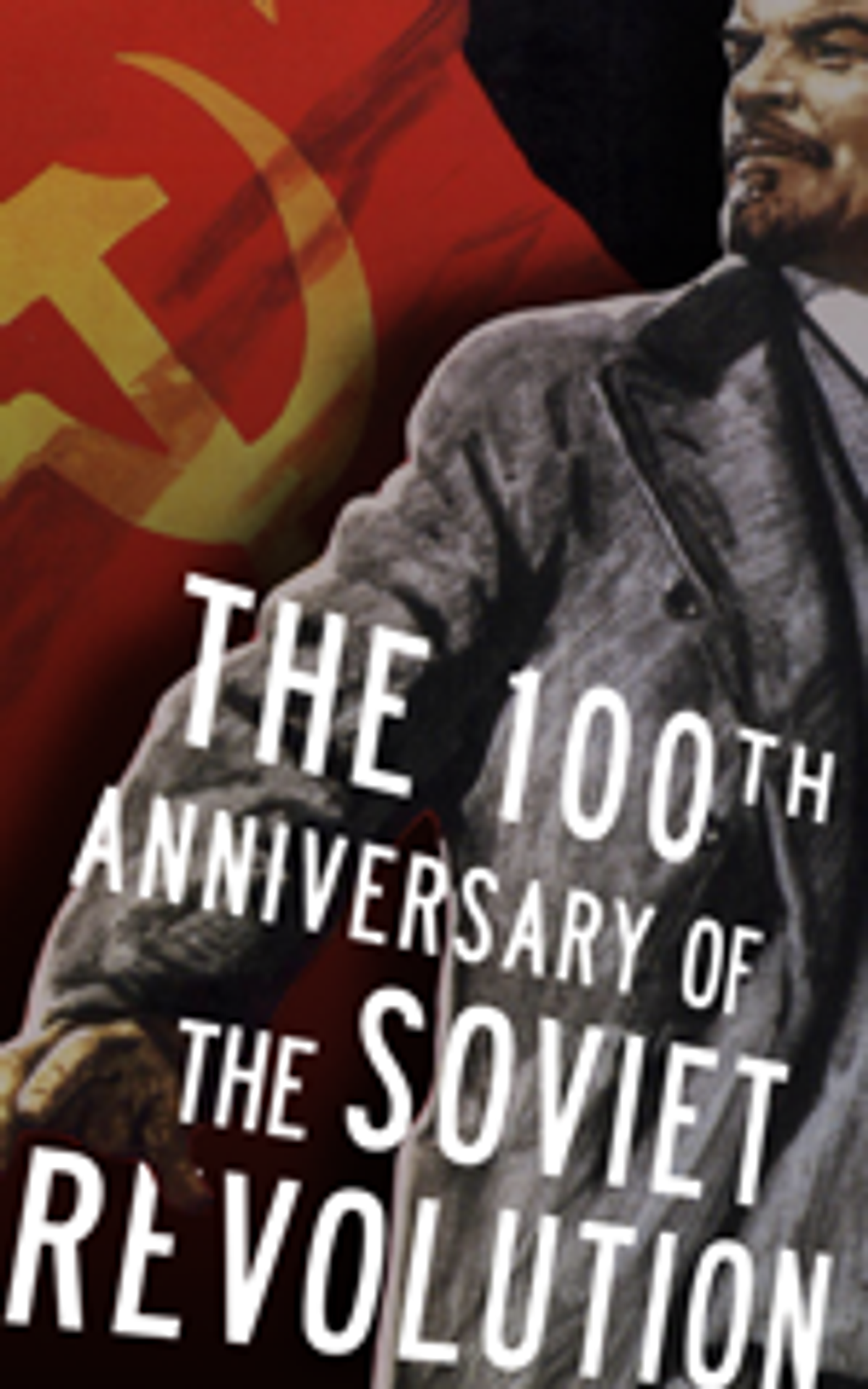When Vladimir Ilyich Ulyanov, later known as Lenin, was 21, famine hit Russia’s Volga region, near the Ulyanovs’ hometown of Simbirsk. Vladimir’s sister raised money for the relief effort and visited the sick. But Vladimir, nearly alone among Russian radicals, scorned the effort to save lives. The future Lenin hoped that a truly enormous death toll would weaken the czarist regime—so the more starvation, the better. “He conducted systematic and outspoken propaganda against the relief committees,” his comrade Trotsky said much later. Four-hundred thousand people died of starvation, typhus, and cholera.
On the 100th anniversary of the Bolshevik seizure of power, we need to remember that Lenin was not just a proponent of mass terror, but also a man who wanted to turn moral values on their head. For him, as for his heir, Stalin, the dead were just numbers. Human life counted for nothing next to the distant, all-important goal of a Communist future. “Our morality is new,” Lenin said in 1918. “To us, all is permitted. … Blood? Let there be blood … for only the complete and final death of th[e] old world will save us from the return of the old jackals.” As it turned out, the new revolutionary jackals were worse than the old czarist ones.
Lenin pioneered the use of mass terror for political control. A post-truth leader, he invented fake news. He proclaimed dazzlingly simple solutions: Destroy legal and institutional norms, expropriate the property of the rich, and Russia would be on the path to Utopia. “The peasants must seize the estates,” Lenin announced in the spring of 1917. “They must be masters now.” “Break the resistance of a few dozen millionaires,” he added, and workers could take over the factories. It was that simple.
But these were lies. No workers were given power, and the peasants got no land. Dealing in wish-fulfillment instead of real politics, inventing enemies to cement one’s power, broadcasting tailor-made facts through subservient news outlets: In all these respects Lenin’s revolution is still with us a century later. Though the West is in few ways comparable to the Soviet Union under Lenin, today’s populists left and right have studied his rulebook, which is why Steve Bannon has reportedly boasted of being a “Leninist.”
The Bolshevik coup disproves the Marxist idea that social and economic forces rule history, as Victor Sebestyen comments in his engaging, highly readable new life of Lenin (Lenin: The Man, the Dictator, and the Master of Terror). Without Lenin’s shrewd tactics, his movement would have been just as feeble as the rest of Russia’s political parties. The Bolsheviks never enjoyed wide support, but they had Lenin’s Machiavellian individual brilliance. Lenin’s tactics were masterful: Encourage schisms; castigate your opponents; make no compromises; refuse all coalitions. He held fast to the key plank that the Mensheviks foolishly rejected: He would end the war immediately upon taking power.
In October 1917 Russia was slowly falling into chaos under Kerensky’s provisional government. The Bolshevik seizure of power had been rumored for weeks; everyone knew it was coming. One newspaper even announced the exact date, Oct. 25. On the night of the 24th, a disguised Lenin made his way through Petrograd, formerly St. Petersburg. He had shaved off his signature beard, donned glasses and a wig, and was clutching a handkerchief to his face. Accompanied by a bodyguard, he reached the Smolny, the revolutionary headquarters, which stank of urine and cigarettes. Lenin and Trotsky couldn’t sleep from excitement, but they lay down to rest on the floor. At 2 a.m., when the revolt began, Lenin turned to Trotsky and said, in German, Es schwindelt (It’s dizzying). Then—shockingly, because Lenin was a proud atheist—he made the sign of the cross. By sunset on the next day, the Bolsheviks had won, in a nearly bloodless coup. There were no barricades or massed crowds. Most of Petrograd’s citizens had no idea that a revolution had occurred.
Sebestyen offers an insightful account of Lenin’s early years in Simbirsk. His father, Ilya Ulyanov, was a school inspector; when he got the post he also became a member of the Russian nobility. Young Vladimir was a brilliant, intensely disciplined student, the best in his school, and a superior chess player. He seems to have had no interest in politics until the day in 1887 when his older brother Sasha, age 20, was arrested for plotting to kill the czar. Despite the family’s pleas, Sasha was executed, and the 17-year-old Vladimir plunged with total dedication into radical politics. Sebestyen speculates that Lenin’s hatred for bourgeois liberals stemmed from the behavior of his Simbirsk neighbors after Sasha’s death: they stopped visiting the Ulyanovs. “The bourgeois,” Lenin liked to proclaim, “will always be traitors and cowards.”
Lenin was aloof by nature. One prominent Bolshevik, Nikolai Valentinov, said that he never saw Lenin put his hand on anyone’s shoulder, and no one would dare to do it to him. He did gymnastic exercises each morning and took afternoon walks when he could. Surprisingly, Lenin loved the outdoors and he play-acted the country squire at his dacha. He liked to go on fox and duck hunts, though he was too squeamish to shoot much. He famously told Maxim Gorky that he couldn’t listen too often to his favorite music, Beethoven’s Appassionata sonata because he would become soft. His hero was the brutal, coldly efficient revolutionary Rakhmetev in his favorite novel, Nikolai Chernyshevsky’s What Is to Be Done?. When he tried to loosen up the results could be faintly comical: During his brief exile in England, Lenin visited working-class music halls and reported that the shows were “a little complicated but interesting.”
Lenin wasn’t greedy, vain, or addicted to luxury, the usual motives that most of us attribute to the power-hungry. Lenin dressed shabbily, in a peaked worker’s cap and heavily worn suit. He and his wife, Nadya Krupskaya, lived frugally, unlike most of the Bolshevik inner circle. He enjoyed power. As Trotsky admitted, Lenin was in effect the dictator of Soviet Russia until a stroke incapacitated him in 1922. He wanted, and got, supreme power, convinced that he was the mind of the revolution. Rosa Luxemberg discerned in him, accurately, “the sterile spirit of the overseer,” rigid and fanatical.
Terrorist assassination seemed to Lenin an undisciplined and aimless tactic despite its popularity among Russian revolutionaries, who killed nearly 20,000 czarist officials during the last 25 years of the Romanov dynasty. Instead, during his long years of exile in Western Europe (1903-1917) he stressed propaganda and spying. Lenin became an expert at sending messages in invisible ink and smuggling radical newspapers into Russia. Still, the Bolsheviks were minor-league players in the vast landscape of Russian radicalism. They had to sit out the 1905 revolution as well as the February revolution of 1917, which brought Kerensky’s Mensheviks to power. (In a brilliant comms ploy, Lenin had named his own party the Bolsheviki, “majority,” and his liberal rivals the Mensheviki, “minority.”)
Sebestyen points out that Lenin would probably never have come to power were it not for Germany. The Germans brought him from Zurich to Petrograd in April 1917, trusting that a Bolshevik victory would knock Russia out of the war. In the sealed train heading to the Finland Station with its cargo of 60 Bolsheviks, the impatient Lenin flew into sudden rages—his fits of anger, like his insomnia, were characteristic. He banned smoking in the train and issued tickets so that his followers could line up to smoke in the bathrooms: the first instance of Soviet bureaucracy, as Sebestyen notes. Germany also supplied funds, through an agent nicknamed Parvus (Alexander Helphand), a louche, obese, high-living employee of the kaiser.
When Lenin returned to Russia there were only 3,000 Bolsheviks, and the party was broke. With German money, Lenin printed hundreds of thousands of copies of his party newspaper, Pravda, and he became famous throughout Russia. But the German help went only so far. After the October Revolution, the party was still short of cash, so Lenin organized a hasty robbery of the Russian National Bank, which was on strike against the new government. Under the eyes of gun-toting Bolsheviks, bank clerks stuffed wads of rubles into sacks and, Sebestyen writes, “this was the first Soviet Treasury.”
The day after the Bolsheviks took power, Lenin began censoring newspapers, just a few days after he had proclaimed that the new regime would uphold press freedom. It wasn’t long before the rule of terror took hold in the Marxist state. After a young socialist named Fanny Kaplan tried to kill him in August 1918, Lenin let loose the Cheka, his secret police, who massacred over a thousand “bourgeois hostages.” Lenin reminded Grigory Zinoviev, a member of the Bolshevik inner circle, that “the dictatorship means—take note of this once and for all—unrestrained power and the use of force, not of law.” Laws were a bourgeois invention, unsuitable for revolutionaries. Mass killing became the main strategy to put down rebellion, as with Trotsky’s massacre of striking sailors at Kronstadt in 1921.
Sebestyen does what he can with Lenin’s wife, Nadya Krupskaya. Lenin proposed to Nadya from a Siberian jail cell in 1897, writing in invisible ink. She came to Siberia, and she and her mother joined him in European exile after 1903. After the Bolshevik victory Nadya was in charge of removing such dangerous books as Kant, Descartes, and Schopenhauer from Soviet libraries. She is a colorless figure, much like Lenin’s mistress, Inessa Armand, whose children Lenin and Krupskaya took care of after Inessa’s death in 1920. Both Nadya and Inessa were true believers who saw the revolution embodied in the man they loved. No matter how cold-blooded Lenin’s decisions, neither of them quailed. Their hatred for “the enemy” was just as fervent as Lenin’s own. One fellow Bolshevik said of Inessa that “she spoke a number of languages fluently, and in all of them repeated Lenin verbatim.”
Land, peace, and bread was Lenin’s rabble-rousing mantra in 1917. But the Bolsheviks proceeded to make war on the peasantry, “requisitioning” their grain and livestock so they could feed the urban population. Peasants were tortured and shot, their villages burned down, and in at least one case, were gassed, if they failed to meet Bolshevik demands. By 1921 the Soviet countryside had exploded in revolt.
In order to survive Soviet Russia needed control over Ukraine, Anne Applebaum explains in Red Famine: Stalin’s War on Ukraine, her meticulous new history of the mass starvation that occurred there in 1933. Ukraine was the home of “black earth,” the rich soil that still produces two abundant harvests a year. Without Ukraine, it was impossible to feed the Soviet masses. The Bolsheviks started plundering Ukraine’s resources almost as soon as they took power, but their mismanagement reduced the region’s yields. In Ukraine as elsewhere they imposed collective farms, which led to economic failure: There was little incentive to work hard if you couldn’t keep what you harvested. The New Economic Policy that Lenin instituted in 1921 was just a different kind of failure. It generated a wave of corrupt entrepreneurs, and a few years later collectivization was back in place.
The Bolsheviks brought class struggle to the Ukrainian countryside just as they did to other regions. They demanded that Ukrainians go to war against wealthy peasants, called kulaks. The term was so elastic that villages sometimes drew lots to decide who among them would get to be kulaks. After the disastrous harvest of 1932, the peasants faced a Catch-22. If their yield was poor, they were punished for not meeting quotas; but if they thrived they would be denounced as kulaks. In either case, they risked a lengthy prison sentence or starvation.
Applebaum stresses that Stalin, even more than Lenin, was worried about losing Ukraine. Stalin wanted to break the back of Ukrainian nationalism, and starvation was the way to do it. In fall 1932 the word went out from the Kremlin to seize all stores of grain and livestock from “underperforming” Ukrainian farmers. No “hoarding” was to be permitted, not even keeping seed grain for the next harvest.
By January 1933 stealing small amounts of food was punished by 10 years in the Gulag and in some cases death. Stalin sealed the borders of Ukraine. Villagers were forbidden to travel to the cities, where there was more food. In 1933, while millions died of hunger in Ukraine, the Soviet Union exported record amounts of Ukrainian butter and bacon.
Stalin had the eager help of Western journalists in his engineering of mass death. His key apparatchik was The New York Times reporter Walter Duranty, who had a luxury apartment and a mistress in Moscow. Duranty, a Pulitzer Prize winner for his political journalism, wielded influence: FDR carefully read his dispatches from the “progressive” Soviet state.
Duranty knew that starvation had hit Ukraine, but told Times readers it was just a fable. “Conditions are bad, but there is no famine,” he wrote. He openly championed the cruelty of the Soviet regime. “The vivisection of living animals is a sad and dreadful thing,” Duranty reported in 1935, “and it is true that the lot of kulaks and others who have opposed the Soviet experiment is not a happy one,” but “in both cases, the suffering inflicted is done with a noble purpose.” In the end, nearly 4 million Ukrainians starved to death.
Applebaum argues that for Stalin the famine was a success. Ukraine was crushed, rendered politically impotent. Even more important, Stalin had revised reality itself. “Those who were starving were not victims; they were perpetrators,” Applebaum writes. The peasants had missed their quotas, and their guilt was unmistakable. To adapt Trotsky’s phrase, they were ready for the dustbin of history.
It is a terrible reality, noted by Applebaum, that most of the people who condemned Ukrainian peasants to starvation were themselves Ukrainian peasants. They “requisitioned” grain and livestock from their neighbors for many reasons, not just survival but the desire for power and also out of Marxist idealism. The striking truth is that under the Soviet system taking food from a family dying of hunger could be made to seem an act with, to use Duranty’s phrase, a “noble purpose.” This was an innovation in political science. Before the Soviet era, it was human beings who killed each other. Now, under Lenin and Stalin, history itself exterminated class enemies.
Bolshevism was a vastly simplified religion masquerading as science. Lenin said he had solved the formula of history, and so had changed the world. The crimes committed by your rulers are the work of the dialectic, and therefore no crimes at all: For a time Soviet citizens may have believed this gospel or pretended to believe it. But long before Stalin’s death, the Soviet Union had become a realm of cynicism, apathy, and fear. Now it too has been consigned to the dustbin of history, but its lessons remain. We can hear echoes of Leninism not only in Putin’s new totalitarianism, as Masha Gessen has called it, but here at home with a leader who depends on agitprop, scapegoating, and artificial facts. The Bolshevist specter refuses to die off.
This article is part of a week-long Tablet series analyzing the 100th anniversary of the Soviet Revolution.


